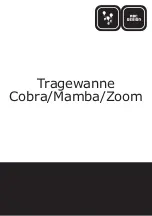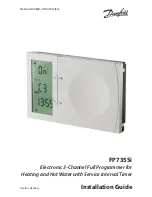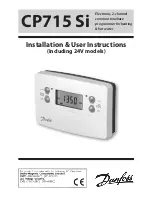
32-73 Integral Limit Filter Time
Range:
Function:
low synchronisation errors are requested, but no
hard regulation at standstill is desired.
Using a value <0 only activates the integral part
of the PID position control loop at standstill. If
the motor starts to move, the integral part is
reduced to 0 by decreasing the integration limit
within the period of time given by the absolute
value set in parameter
32-73 Integral Limit Filter
Time
. If the motor stops again, the integration
limit increased from 0 to the value defined in
parameter
32-63 Limit Value for Integral Sum
within the defined period of time. This handling
of the integral part can be helpful to prevent
unstable motor behaviour during a movement,
but still ensure an accurate positioning result at
standstill.
Also see parameters
32-60 Proportional Factor
and
32-61 Derivative Value for PID Control
.
32-74 Position Error Filter Time
Range:
Function:
0
*
[0–
10000]
Time frame in milliseconds for triggering position
error state. Too large tracking errors (parameter
19-93 Error Status
= 9) only trigger an error state if
they exist longer than the position error filter
time set in this parameter.
The default value is [0]. If the value is not [0],
then a position error is only produced if the value
in parameter
32-67 Maximum Tolerated Position
Error
is exceeded for a time longer than the
position error filter time.
5.6.5 32-8* Velocity & Acceleration
The 32-8* parameters specify velocity, acceleration, and
ramp.
32-80 Maximum Velocity (Encoder)
Range:
Function:
1500
*
[1–
100000
RPM]
This parameter defines the rated speed of the
motor. This value is listed in RPM and is
needed for the calculation of ramps and
actual velocities.
The nominal speed refers to the speed of the
encoder.
For linear encoders, this equals the number of
increments per minute divided by the value
in parameter
32-01 Incremental Resolution
or
32-03 Absolute Resolution
.
32-81 Shortest Ramp
Range:
Function:
1.000
*
[0.001–
3600.000 s]
This parameter determines the shortest
ramp (maximum acceleration). It indicates
the length of the minimum acceleration
32-81 Shortest Ramp
Range:
Function:
phase to achieve the rated velocity. Always
set the ramps via the option card and not
in the frequency converter. The frequency
converter ramps (parameters
3-41
and
3-42
)
must always be set to minimum.
32-82 Ramp Type
This parameter defines the ramp type: trapeze, sinusoidal, or
limited jerk. These ramp types are relevant for all movements.
Option:
Function:
[0]
*
Linear
130BD768.10
1
2
3
0
50
100
150
200
250
300
350
400
450
Illustration 5.4 Linear Ramp
1 = Acceleration
2 = Speed
3 = Position
[1]
S-ramp
130BD769.10
1
2
3
0
50
100
150
200
250
300
350
400
450
Illustration 5.5 S-Ramp
1 = Acceleration
2 = Speed
3 = Position
[2]
Movements with
limited jerk
130BD770.10
1
2
3
0
50
100
150 200 250
300 350
400 450
500 550
Illustration 5.6 Movements with
Limited Jerk
1 = Acceleration
2 = Speed
3 = Position
Movements with limited jerk start with acceleration 0 and
increase acceleration by maximum jerk until the maximum
acceleration (defined by parameter
32-81 Shortest Ramp
) is
Commissioning
Operating Instructions
36
Danfoss A/S © 04/2014 All rights reserved.
MG33R302
5
5
















































